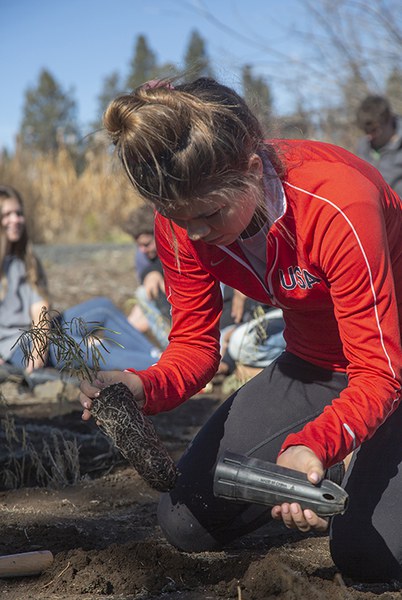As the early morning air cools, leaves start their autumnal display, and whispers begin about pumpkin spice and apple cider, we also start to think about… planting?!? Yes, that’s right! Fall is a great time for planting in Central Oregon! Learn more about why you should think about adding to your yard or garden between August and October.
One of the biggest reasons to plant in the fall is the warm soil and cooler air. Plants generally love warm soil and also enjoy moderate temperatures. In the fall, plants get this ideal combination. What do plants do when they get their ideal? They develop their root systems, which makes them more resilient in our high desert climate. Generally, plants that have more shallow, fibrous root systems benefit from being planted in the fall, while plants with a few, deep roots prefer to be planted in the spring. Roots will continue to develop until soil temperatures fall below around 40 degrees Fahrenheit. In addition, plants transplanted in the fall will have established a stronger root system by the time spring rolls around, so they can devote their energy elsewhere (like on beautiful blooms or new growth!).
By planting new vegetation in the fall, you’re also helping them get a leg up before insects and weeds impact their growth. Spring and summer usually bring a wealth of insects to our yards and gardens, and they seem to select our favorite plants for a large meal (or is this just in my garden?). Likewise, weeds tend to be some of the first plants to pop up in the spring, spreading and taking over nutrients that your plants want.
All of these reasons taken together show that fall is often a time of reduced stress for plants. Transplanting will always cause stress on a plant. Minimizing this impact can help your plant survive. In the fall, your plant is focused on storing energy in its root system before it enters dormancy in the winter. This process is less stressful than going straight into the strain that summer can have.
And let’s not forget—sometimes planting in the fall is easier on you! Granted, it might not be as inspiring when you plant what looks like a dead, brown stalk into the ground. By planting during this time of year, though, you’re more apt to remember problem areas, see gaps in your vegetation, and be more aware of wildlife’s impact on your garden (RIP to all my plants that have been eaten by deer).
As you prepare for fall plantings, keep in mind that your plants have root systems that have been growing all season and they might be rootbound when you get them. Mike Lattig, owner of Clearwater Native Plant Nursery in Redmond, recommends that you "carefully work the roots off the root ball and strip out/remove the roots that are spiraling around the bottom of the container." In addition, since plants will be entering dormancy soon, therefore using less nutrients right now, you'll want to be careful not to overfertilize your new plants. Just a little bit of compost mixed in your soil goes a long way during the fall.
We hope you’ll join us in grabbing our trowel and heading to the plant nursery. Because it’s fall, and that means planting time around here.
Sources:
Mike Lattig, Clearwater Plant Nursery
Four Reasons You Should Plant in the Fall, Dyck Arboretum of the Plains
6 Reasons Why Fall is for Planting, New Garden Landscaping & Nursery
Learn more:
- Join the Land Trust for a fall planting party! Check out our Volunteer Opportunities
- Tips + Tricks for Caring for Native Plants
- Pollinator Plants to Grow


